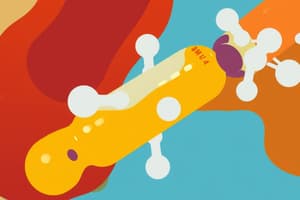Podcast
Questions and Answers
What is another name for pantothenic acid?
What is another name for pantothenic acid?
- Pyridoxal
- Butyric acid
- Pyridoxine
- Chick an derma s factor (correct)
Which of the following is NOT a dietary source of vitamin B5?
Which of the following is NOT a dietary source of vitamin B5?
- Fruits (correct)
- Animal organs
- Cereal grains
- Vegetables
What is one of the primary functions of vitamin B5 in the body?
What is one of the primary functions of vitamin B5 in the body?
- Synthesis of neurotransmitters (correct)
- Regulating blood sugar levels
- Production of red blood cells
- Formation of collagen
What deficiency symptom is associated with pantothenic acid?
What deficiency symptom is associated with pantothenic acid?
Which compound is commonly associated with vitamin B6?
Which compound is commonly associated with vitamin B6?
Vitamin B5 contributes to the repair of which of the following?
Vitamin B5 contributes to the repair of which of the following?
Which of the following is a function of vitamin B5 related to lipids?
Which of the following is a function of vitamin B5 related to lipids?
Which disorder is linked to a deficiency of vitamin B6?
Which disorder is linked to a deficiency of vitamin B6?
What is the primary function of chlorophyll in photosynthesis?
What is the primary function of chlorophyll in photosynthesis?
Which of the following statements about erythromycin is correct?
Which of the following statements about erythromycin is correct?
Which step is NOT part of the photosynthesis process?
Which step is NOT part of the photosynthesis process?
What are secondary metabolites exemplified by antibiotics such as erythromycin and bacitracin primarily used for?
What are secondary metabolites exemplified by antibiotics such as erythromycin and bacitracin primarily used for?
What is one of the critical roles of vitamin B12 during early pregnancy?
What is one of the critical roles of vitamin B12 during early pregnancy?
In the photosynthesis equation, what is produced as a result of the process?
In the photosynthesis equation, what is produced as a result of the process?
Which condition is associated with a deficiency of vitamin B12?
Which condition is associated with a deficiency of vitamin B12?
Which type of pigment is most prevalent in green plants and primarily responsible for capturing light energy?
Which type of pigment is most prevalent in green plants and primarily responsible for capturing light energy?
What is the role of water in the process of photosynthesis?
What is the role of water in the process of photosynthesis?
What role does vitamin B12 play in the metabolism of amino acids?
What role does vitamin B12 play in the metabolism of amino acids?
What is the most stable form of vitamin B12 used in therapy?
What is the most stable form of vitamin B12 used in therapy?
Where does the majority of photosynthesis occur within plant cells?
Where does the majority of photosynthesis occur within plant cells?
How does vitamin B12 impact nerve health?
How does vitamin B12 impact nerve health?
What is one of the metabolic processes vitamin B12 is involved in?
What is one of the metabolic processes vitamin B12 is involved in?
Which nutrient's metabolism is NOT directly associated with vitamin B12?
Which nutrient's metabolism is NOT directly associated with vitamin B12?
Which of the following is a risk factor for developing Beri Beri?
Which of the following is a risk factor for developing Beri Beri?
What type of anemia is prevented by the function of vitamin B12?
What type of anemia is prevented by the function of vitamin B12?
What is the main dietary source of riboflavin?
What is the main dietary source of riboflavin?
Which of the following statements about riboflavin (Vitamin B2) is true?
Which of the following statements about riboflavin (Vitamin B2) is true?
What role does riboflavin play in the body?
What role does riboflavin play in the body?
During the absorption of riboflavin, which factor enhances its uptake into intestinal cells?
During the absorption of riboflavin, which factor enhances its uptake into intestinal cells?
Where does riboflavin occur in food?
Where does riboflavin occur in food?
Which vitamin is NOT converted into its active coenzyme form by riboflavin?
Which vitamin is NOT converted into its active coenzyme form by riboflavin?
What happens to riboflavin when exposed to light?
What happens to riboflavin when exposed to light?
What is the primary function of cardioactive glycosides on cardiac muscle?
What is the primary function of cardioactive glycosides on cardiac muscle?
Which of the following describes the structure of the cardenolide?
Which of the following describes the structure of the cardenolide?
Which of the following is a glycoside type that contains a six-membered lactone ring?
Which of the following is a glycoside type that contains a six-membered lactone ring?
What characteristic is common to all cardioactive glycosides?
What characteristic is common to all cardioactive glycosides?
What type of aglycone is represented by digitoxigenin?
What type of aglycone is represented by digitoxigenin?
Which of these components can be linked in series at the glycone portion of cardiac glycosides?
Which of these components can be linked in series at the glycone portion of cardiac glycosides?
In the scilladienolide, which lactone ring type is attached at C-17?
In the scilladienolide, which lactone ring type is attached at C-17?
Which position of the cardiac glycosides is NOT identified as having an OH group?
Which position of the cardiac glycosides is NOT identified as having an OH group?
Flashcards are hidden until you start studying
Study Notes
### Antibiotics
- Erythromycin is an antibiotic used to treat a variety of bacterial infections.
- It is derived from a bacteria called Saccharopolyspora erythraea.
- Erythromycin is commonly administered orally.
- Bacitracin is another common antibiotic used topically.
- Bacitracin is produced by bacteria called Bacillus subtilis.
Photosynthesis
- Photosynthesis is the process by which light energy is converted into chemical energy in the form of glucose.
- This process occurs in chloroplasts.
- The chemical equation for photosynthesis is: 6CO2 (carbon dioxide) + 12 H2O (water) + light energy -> C6H12O6 (glucose) + 6O2 (oxygen) +6H2O (water).
Steps of Photosynthesis:
- Carbon dioxide enters the plant through openings called stomata.
- Water is absorbed from the soil by root hairs and transported to the leaves through xylem vessels.
- Chlorophyll absorbs light energy from the sun, which splits water molecules into hydrogen and oxygen.
- Hydrogen and carbon dioxide are used to produce glucose.
- Oxygen is released into the atmosphere as a waste product.
- Glucose is used for plant growth and development and stored in roots, leaves, and fruits for later use.
### Pigments
- Pigments are molecules that absorb specific wavelengths of light and reflect the unabsorbed light.
- Green plants contain chlorophyll a, chlorophyll b, and carotenoids.
- Chlorophyll a is the main pigment that captures light energy.
### Vitamin B2 - Riboflavin
- Riboflavin is a yellow, heat-stable vitamin that is slightly soluble in water.
- It is sensitive to light and degrades into lumichrome or lumiflavin when exposed to light.
- Riboflavin's richest natural source is yeast.
- Other good sources include dairy products, eggs, legumes, and meats.
- Riboflavin is stable during cooking in the absence of light.
### Uses of Vitamin B2
- Riboflavin acts as a coenzyme in oxidation-reduction reactions.
- It is involved in releasing energy from carbohydrates, fats, and proteins.
- Riboflavin stimulates growth and reproduction.
- It plays a role in vision.
- Riboflavin helps convert vitamins B6, folic acid, and niacin into their active coenzyme forms.
### Vitamin B5 - Pantothenic Acid
- Pantothenic acid is a component of the vitamin B complex.
- It is also known as the "chick antidermatitis factor".
- It is naturally occurring compound that is broken down into B-alanine and pantoic acid upon hydrolysis.
- Rich sources of pantothenic acid include animal organs (heart, kidney, liver), and cereal grains.
### Uses of Vitamin B5
- Pantothenic acid is involved in turning food into energy.
- It is involved in the synthesis of lipids, neurotransmitters, steroid hormones, and hemoglobin.
- It helps in maintaining and repairing tissues and cells of the skin and hair.
- It helps in healing of wounds and lesions.
- It helps in maintaining normal blood lipid levels.
### Vitamin B6
- Vitamin B6 refers to pyridoxol, pyridoxal, and pyridoxamine.
- These are three closely related, naturally occurring, highly substituted pyridine derivatives with comparable physiological activity.
- Pyridoxine is the term used for pyridoxol in pharmacy and medicine.
- Vitamin B6 helps in the production of DNA and RNA.
Uses of Vitamin B6
- Vitamin B6 is involved in metabolising proteins, carbohydrates, and fats.
- It is involved in the metabolism of vitamins and amino acids.
- It helps in the synthesis of neurotransmitters and amino acids.
- It is crucial during early pregnancy to reduce the risk of birth defects of the brain and spine.
- It is required for the synthesis of glycine, methionine, nucleosides T & U.
### Vitamin B12
- Vitamin B12 (cobalamins) are porphyrin-related corrinoid derivatives that act as extrinsic factors to prevent pernicious anemia.
- Cyanocobalamin is the most stable form of vitamin B12 and is most commonly used in therapy.
- Hydroxocobalamin is another therapeutic form of vitamin B12, where the cyano group is replaced with a hydroxyl group.
### Uses of Vitamin B12
- Vitamin B12 acts as a coenzyme in the conversion of homocysteine to methionine.
- It plays a role in the metabolism of fatty acids and amino acids.
- It is involved in the production of neurotransmitters.
- It maintains the protective lining around nerve fibers.
- It is required for bone cell activity.
- It plays a significant role in DNA synthesis.
### Cardioactive Glycosides
- These glycosides have a highly specific action on cardiac muscle, increasing its tone, excitability, and contractility.
- The aglycone of these glycosides is called a "cardiac genin".
- Cardiac genins are steroid derivatives of cyclopentaphenanthrene containing an unsaturated lactone ring attached to C17.
### Structure of Cardioactive Glycosides
- Two types of genins are distinguished based on the presence of a five- or six-membered lactone ring.
- Cardenolides (e.g., digitoxigenin) have a five-membered lactone ring.
- Bufanolides (e.g., scillarenin) have a six-membered lactone ring.
### Cardenolides
- Cardenolides contain a butenolide (4 carbons) lactone ring attached at C17.
- Examples include glycosides of digitalis and strophanthus species.
- Digitalis glycosides have an R group of CH3.
- Strophanthus glycosides have an R group of CHO or CH2OH.
### Bufadienolides
- Bufadienolides contain a pentadienolide (5 carbons with two double bonds) lactone ring attached at C17.
- Examples include squill glycosides and bufotoxin.
- Squill glycosides have an R1 group of OH and an R2 group of H.
- Bufotoxin has ester groups at both R1 and R2 positions.
### General Properties of Cardioactive Glycosides
- They have a β-OH group at position C-3, involved in a glycosidic linkage to a mono, di, tri, or tetrasaccharide.
- They have another β-OH group at C-14.
- They have an unsaturated 5 or 6-membered lactone ring at position C-17, also in the β configuration.
- Additional OH groups may be present at C-5, C-11, and C-16.
Studying That Suits You
Use AI to generate personalized quizzes and flashcards to suit your learning preferences.





